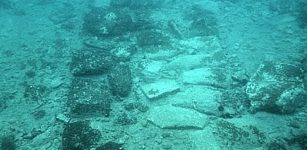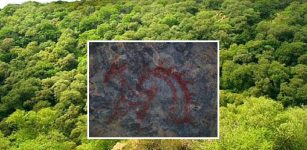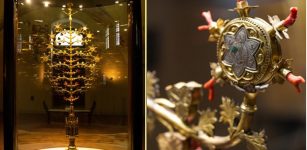How Did These Beautiful Venetian Glass Beads Reach North America Long Before Columbus?
Jan Bartek - AncientPages.com - Archaeologists were surprised to find evidence Renaissance-era Italian glass beads reached North America long before Christopher Columbus made his first journey to the continent.
But maybe the discovery should not be so surprising at all. Nowadays we get more and more scientific confirmation many ancient civilizations visited North America before Columbus set his foot there.
Rare Discovery Of Venetian Glass Beads In Alaska
These glass beads the size of blueberries were found by archaeologists in a Brooks Range house pit. Based on what is known so far it seems they might be the first European items ever to arrive in North America, predating the arrival of Columbus by a few decades.
Archaeologists found these glass beads in northern Alaska. They were made in Venice, Italy, in the 1400s. Credit: American Antiquity, January 2021
Made in Venice, Italy, the tiny blue beads might have traveled more than 10,000 miles in the skin pockets of aboriginal adventurers to reach Bering Strait. There, someone ferried them across the ocean to Alaska.
At least 10 of the beads survived a few centuries in the cold dirt of three locations in northern Alaska.
‘Punyik Point, a mile from the Continental Divide in the Brooks Range, is unoccupied today. It was a seasonal camp for generations of inland Eskimos. Archaeologists have dug at Punyik Point for a long time and made many interesting discoveries.
Many years ago archaeologists found for example three more of the beads near some copper bangles — metal adornments that resemble flat hoop earrings — and other metal bits that might have been part of a necklace or bracelet.
Finding beads at prehistoric Alaska sites does not happen often so it’s certainly a rare and valuable archaeological discovery.
According to Mike Kunz, an archaeologist with the University of Alaska Museum of the North in Fairbanks Punyik Point was on ancient trade routes from the Bering Sea to the Arctic Ocean and was probably a dependable place to hunt caribou as the animals moved in fall and spring.
The beads and copper jewelry found at Punyik Point. Credit: M. L. Kunz et al., 2021, American Antiquity
Eager to learn more about the glass beads scientists sent them to be examined and dated. With that result, later backed up by similar dating on objects found near the same beads at two other Arctic Alaska sites, the archaeologists saw that those pea-size objects told a big story.
“This was the earliest that indubitably European materials show up in the New World by overland transport,” Kunz said.
The beads in the tundra of northern Alaska came from Venice, on the Adriatic Sea half a world away. "Kunz and his colleague archaeologist Robin Millsfound that out by studying the history of glass-bead making in the city of Venice," the University of Alaska Fairbanks reports.
Along with the radiocarbon dating of the Alaska twine and charcoal found near the beads, they figured the beads arrived at Punyik Point sometime between 1440 and 1480, years before Columbus was even thinking of his journey.
How did the beads — found in no other archaeological site west of the Rockies — make their way from the canals of Venice to a plateau in the Brooks Range?
Who Brought The Venetian Glass Beads To Alaska?
How did the beads — found in no other archaeological site west of the Rockies — make their way from the canals of Venice to a plateau in the Brooks Range?
Image: Fossil ivory figurine. Okvik. Punuk Islands. Credit: Froelich Rainey, Penn Museum - Did you know? The Eskimos Say - the ancient city of Ipiutak was built by a fair-haired race with blue eyes and not them. Read more
In the 1400s, craftsmen in the city-state of Venice traded with people throughout Asia. The beads might have traveled in a horse-drawn cart along the Silk Road eastward toward China. From there, “these early Venetian beads found their way into the aboriginal hinterlands, with some moving to the Russian Far East,” the authors wrote in their recent paper published in the journal American Antiquity.
After that great journey, a trader may have tucked the beads into his kayak on the western shore of the Bering Sea. He then dipped his paddle and made passage to the New World, today’s Alaska. The crossing of Bering Strait at its narrowest is about 52 miles of open ocean.
See also: More Archaeology News
Kunz and Mills think the beads found at Punyik Point and two other sites probably arrived at an ancient trading center called Shashalik, north of today’s Kotzebue and just west of Noatak. From there, people on foot, maybe traveling with a few dogs, carried them deep into the Brooks Range.
Someone at Punyik Point might have strung the exotic blue beads in a necklace, which they lost or left behind as they walked away. The tiny blue spheres rested for centuries at the entrance to an underground house north of the Arctic Circle, waiting to be found.
Written by Jan Bartek - AncientPages.com Staff Writer























